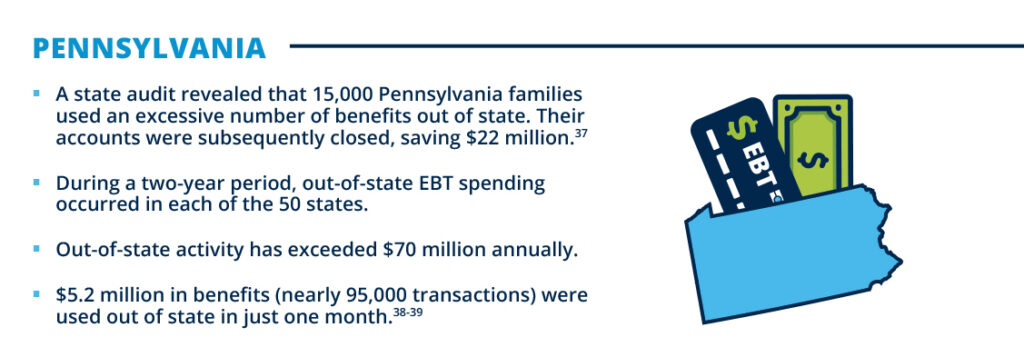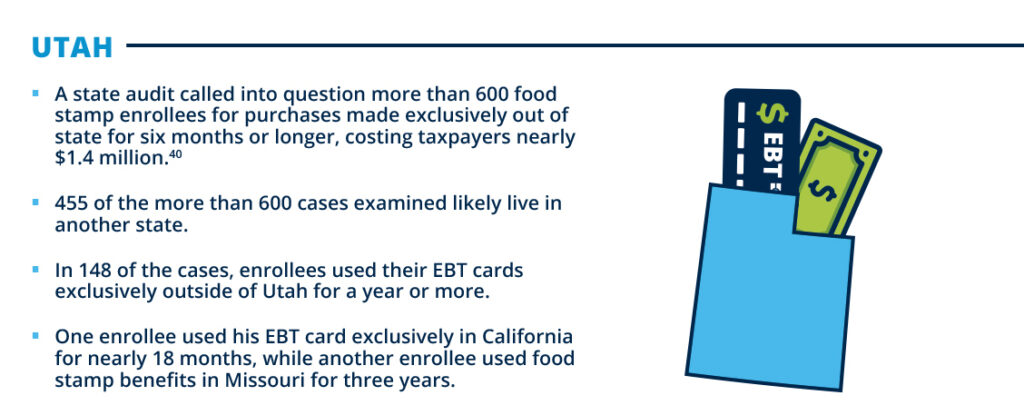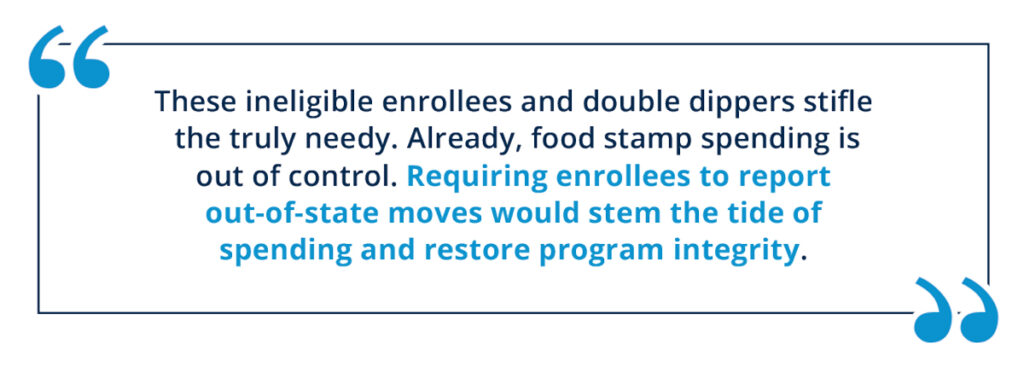Congress Should Restore Program Integrity To Food Stamps By Requiring Enrollees To Report Out-Of-State Moves
KEY FINDINGS
- Millions of Americans change their state of residence every year.
- Food stamp enrollees frequently fail to report changes, including out-of-state moves, that affect their eligibility.
- States have weak reporting requirements and anti-fraud efforts, opening the door to costly fraud.
- Food stamp enrollees have used benefits for years after moving out of state.
- Some food stamp enrollees received benefits in multiple states at the same time.
Overview
Americans are on the move. In 2021, nearly eight million individuals moved to a new state.1 Food stamp enrollees are among those moving.
The food stamp program allows purchases to be made across state lines using an electronic benefits transfer (EBT) card, which functions like a debit card. Food stamp applicants are required to apply for benefits in their home state. But when enrollees change their state of residence, they must cancel food stamp benefits in one state before re-applying in their new state.2 Out-of-state purchases are permitted to uncomplicate interstate travel.3 They are not meant to become the default method for an individual or family with a differing state of residence.

Though food stamp benefits are federally funded, states administer the benefits and pay for some of those costs. And without robust reporting requirements, state agencies are unable to keep up with food stamp enrollees’ out-of-state moves. Congress addressed this issue in 2017 but left it up to the U.S. Department of Agriculture (USDA) to define specific reporting requirements, which they have yet to do.4
Unfortunately, excessive use of food stamps out of state or out-of-state use for an extended period could indicate intentional misuse. Ensuring enrollees actually live in the state through which they receive benefits would ensure states are paying only for their residents. It would also curb fraud, prohibiting those who would game the system from keeping benefits active in their former state while applying for benefits on top of that in their new state of residence—a type of fraud called dual participation.

Moreover, food stamp spending has exploded, reaching a record high in 2022.5 In the four years between 2019 and 2022, food stamp spending nearly doubled.6 With that, fraud also surged.7 In 2020, more than 22,000 administrative disqualification hearings were held on eligibility fraud alone (not including trafficking fraud) where individuals intentionally made false or misleading statements.8
Curbing fraud in the food stamp program is necessary to reduce the program’s cost. Billions of dollars in food stamps are spent fraudulently that should have gone to the truly needy.9-10 Congress has an opportunity to stop the abuse by requiring food stamp enrollees to report their out-of-state moves within 10 days.
Millions of Americans change their state of residence every year.
The COVID-19 pandemic shook up the workforce, causing many Americans to move. Some of these individuals are dependent on food stamps or other welfare programs. In 2021, nearly eight million people moved to a new state.11 Moves between states made up nearly 19 percent of all moves in 2021, an increase credited to COVID-19’s effect on workforce mobility.12
Roughly one-third of Americans moved for a new job or a job transfer.13 And nearly one in four interstate moves were individuals below 150 percent of the poverty level.14 The unemployed were nearly two times as likely to move to a new state in 2022 than the employed.15 This has large implications for welfare programs, particularly food stamps, which are managed by states.
Food stamp enrollees frequently fail to report changes, including out-of-state moves, that affect their eligibility.
The federal government pays for food stamp benefits with taxpayer dollars but shares administrative costs with states.16 The federal government covers approximately 50 percent of the administrative costs, and states pay the other half, totaling $4.38 billion in 2020.17
But states do not enforce requirements to report out-of-state moves immediately after moving. And thanks to simplified reporting, there is hardly any reporting required of food stamp enrollees at all. This opens the door to widespread fraud. States cannot keep up with the many moves if they are not being reported.
In 2022, the food stamp program’s reported error rate was more than 11.5 percent, a 4.18 percentage point increase from 2019.18-19 But the true error rate is likely much higher as the food stamp program ignores payment errors valued below a certain threshold.20 A review by the Government Accountability Office found that nearly 40 percent of cases had payment errors, but most of these were excluded from the official, reported error rate.21

Worse yet, states have a long history of gaming the system in order to artificially lower their error rates. USDA pays states for having the lowest and most improved error rates, incentivizing botched data. In Virginia, USDA paid the state performance bonuses for their low rates.22 But later, Virginia was found to have cooked the books, reporting errors as correct.23 Several states have issued retroactive waivers to cover up prior mistakes, further underscoring USDA’s attempts to reduce their reported error rates.24
States have weak reporting requirements and anti-fraud efforts, opening the door to costly fraud.
Unfortunately, states do little to enforce out-of-state reporting, leading to more fraud. The reporting methodology called simplified reporting is used by most states. This method allows households on food stamps to avoid reporting most changes in income or other eligibility factors.25 Individuals are only required to report changes when their household income rises above the federal eligibility level.26 Change reporting, on the other hand, requires that individuals report all changes (income and other eligibility factors) within 10 days.27
Simplified reporting is essentially an honor system. It tells individuals to request that the state stop sending them money once their income reaches an ambiguous level—a highly unrealistic expectation. The result is a culture of non-verification at the state agencies where most enrollees are assumed to be eligible, and enrollees do not have to report any changes.
Most states use simplified reporting.28 Others use a combination of simplified and change reporting based on the household type.29
Requiring enrollees to report changes, including out-of-state moves, within 10 days would ensure that people only receive benefits for which they are eligible.

State agencies are directly responsible for detecting and prosecuting food stamp fraud.30 Unfortunately, states do not effectively detect or prosecute fraud. Instead, they often alter information and data to manipulate and reduce error rates.31-32 Worse still, USDA prohibits states from automatically denying an applicant that self-declares information that makes them ineligible.33
Following the money can often reveal a program’s priorities. The case is no different here: USDA’s Food and Nutrition Service spends just 0.005 percent of appropriations on anti-fraud efforts.34 Fraud is happening—and it too often goes unreported.
Food stamp enrollees have used benefits for years after moving out of state.
Excessive out-of-state food stamp spending is cause for concern. Out of the total food stamp benefits issued in 2017, nearly $2 billion was spent out of state.35 And nearly one out of every three dollars spent out of state was spent in a non-border state.36 Though some out-of-state food stamp purchases may be legitimate, the numbers are striking.


Generally, excessive out-of-state use is not a single mistake, as some individuals used food stamp benefits for years after moving.
Some food stamp enrollees received benefits in multiple states at the same time.
Oftentimes excessive out of state use points to another type of fraud: enrollees receiving benefits in multiple states at the same time. Countless examples of this type of fraud exist across the country.
In Missouri, one woman received food stamp benefits in four states at the same time.41 She filed 71 food stamp applications and fraudulently received more than $20,000 in benefits over more than two years.42 This was all done using her own name.43
A Wisconsin audit revealed multiple enrollees who were receiving food stamps in other states in addition to Wisconsin-issued benefits.44 The same audit identified Wisconsin-issued EBT cards used in all 50 states and each U.S. territory.45
A Utah audit found one recipient received benefits from both Utah and Nevada for multiple years.46 The recipient used his Utah EBT card exclusively outside of Utah for nearly all transactions. He applied for Utah benefits in September of one year and applied for Nevada benefits just three months later.47
Multi-state EBT abuse is made worse by states not sharing information. If more states shared information, multi-state EBT fraud could be reduced.

In 2011, a grant to USDA funded a searchable database program that spanned five southern states: Alabama, Florida, Georgia, Louisiana, and Mississippi.48 This database, the National Accuracy Clearinghouse (NAC), was a tool to curb duplicative enrollment in food stamps across states. The 2018 Farm Bill mandated all states to actively participate in NAC by the end of 2021.49 Unfortunately, USDA has ignored the law, circumventing it by constructing a new tool and thereby delaying the national NAC implementation until 2027.50-51 This six-year delay will cost $1.85 billion according to the United Council on Welfare Fraud.52
The NAC pilot program was an overall success. After just one year, a report found a 46 percent reduction in food stamp enrollees receiving benefits in more than one pilot state.53 Each of the five states saw a reduction in dual participation. For example, the percentage of duplicate participants fell from 21 percent to zero percent in Alabama and 51.4 percent to 17.8 percent in Florida.54 In Alabama after implementing NAC, fewer than one percent of those flagged for dual enrollment were still enrolled two months later and none were still enrolled four months later.55
The NAC pilot’s success is proof that out-of-state food stamp fraud is a real issue.
The Bottom Line: Congress can restore program integrity to food stamps by requiring individuals to report out-of-state moves within 10 days, preserving resources for the truly needy.
Using false pretenses to collect food stamps in a place an individual does not live should never go unchecked. This wastes taxpayer resources and diverts them from the truly needy.
Congress should require that food stamp enrollees report their out-of-state moves within 10 days, the original eligibility requirement in federal law.56
Food stamps are a lifeline for truly needy families. But with duplicates and ineligible individuals on the rolls, resources are wasted. And that is the responsibility of the state. The states pay for those added administrative expenses. These ineligible enrollees and double dippers stifle the truly needy. Already, food stamp spending is out of control. Requiring enrollees to report out-of-state moves would stem the tide of spending and restore program integrity.

References
1 2021 is the most recent year with fully available data. Census Bureau, “State-to-state migration flows,” U.S. Census Bureau (2023), https://www.census.gov/data/tables/time-series/demo/geographic-mobility/state-to-state-migration.html.
2 Benefits.gov, “Transferring benefits across states,” Benefits.gov (2022), https://www.benefits.gov/news/article/461.
3 Cornell Law School, “7 CFR § 274.8 functional and technical EBT system requirements,” Legal Information Institute (2023), https://www.law.cornell.edu/cfr/text/7/274.8.
4 Sam Adolphsen, “Some food stamp enrollees are collecting benefits in multiple states—USDA can put an end to it,” The Hill (2019), https://thehill.com/blogs/congress-blog/politics/466162-some-food-stamp-enrollees-are-collecting-benefits-in-multiple/#:~:text=In%202017%2C%20Congress%20passed%20a,however%2C%20has%20never%20been%20implemented.
5 Jonathan Ingram, “Feeding inflation: President Biden’s unlawful food stamp expansion is costing taxpayers and consumers billions…And Congress can stop it,” Foundation for Government Accountability (2023), https://thefga.org/research/congress-could-save-repealing-bidens-unlawful-food-stamp-expansion.
6 Ibid.
7 Liesel Crocker, “Five ways that Congress can put a stop to food stamp fraud,” Foundation for Government Accountability (2023), https://thefga.org/research/five-ways-congress-can-stop-food-stamp-fraud.
8 Food and Nutrition Service, “State activity report, fiscal year 2020,” U.S. Department of Agriculture (2022), https://fns-prod.azureedge.us/sites/default/files/snap/14-State-Options.pdf.
9 FGA, “Six ways criminals commit welfare fraud—And six ways to stop it,” Foundation for Government Accountability (2020), https://thefga.org/blog/six-ways-criminals-commit-welfare-fraud/.
10 FGA, “FGA comments on new GAO report on food stamp fraud,” Foundation for Government Accountability (2019), https://thefga.org/press/fga-comments-on-new-gao-report-on-food-stamp-fraud/.
11 Mehreen S. Ismail et. al., “More people moved across state lines in 2021 than in 2019, many to neighboring states,” U.S. Census Bureau (2023), https://www.census.gov/library/stories/2023/06/state-to-state-migration.html#:~:text=Nearly%207.9%20million%20people%20in,of%20all%20movers%20in%202019.
12 Ibid.
13 United Van Lines, “Annual 2021 United Van Lines national movers study,” United Van Lines (2021), https://www.unitedvanlines.com/newsroom/movers-study-2021.
14 Author’s calculations based upon data from the U.S. Department of Commerce on geographic mobility and poverty status. Census Bureau, “Geographical mobility in the past year by poverty status in the past 12 months for current residence in the United States,” U.S. Census Bureau (2021), https://data.census.gov/table?q=mobility+and+migration+by+poverty+status&tid=ACSDT1Y2021.B07012.
15 Author’s calculations based upon data from the U.S. Department of Commerce on geographic mobility. Census Bureau, “Table 2: General mobility of persons at least 16 years old, by labor force status, and by sex, race and Hispanic origin, and region: 2022,” U.S. Census Bureau (2022), https://www.census.gov/data/tables/2022/demo/geographic-mobility/cps-2022.html.
16 Food and Nutrition Service, “State activity report, fiscal year 2020,” U.S. Department of Agriculture (2022), https://fns-prod.azureedge.us/sites/default/files/snap/14-State-Options.pdf.
17 Ibid.
18 Food and Nutrition Service, “Supplemental nutrition assistance program: Payment error rates fiscal year 2022,” U.S. Department of Agriculture (2023), https://fns-prod.azureedge.us/sites/default/files/resource-files/snap-fy22-qc-payment-error-rate.pdf.
19 Food and Nutrition Service, “Supplemental nutrition assistance program: Payment error rates fiscal year 2019,” U.S. Department of Agriculture (2020), https://fns-prod.azureedge.us/sites/default/files/resource-files/FY2019SNAPQCPaymentErrorRateChartGeneric.pdf.
20 Victoria Eardley and Jonathan Ingram, “The case for ending auto-enrollment in Medicaid,” Foundation for Government Accountability (2019), https://thefga.org/research/ending-medicaid-auto-enrollment/.
21 Government Accountability Office, “Supplemental nutrition assistance program: Policy changes and calculation methods likely affect improper payment rates, and USDA is taking steps to help address recipient fraud,” U.S. Government Accountability Office (2016), https://www.gao.gov/assets/gao-16-708t.pdf.
22 Office of Public Affairs, “Virginia Department of Social Services agrees to pay $7.1 million to resolve alleged false claims for SNAP funds,” U.S. Department of Justice (2017), https://www.justice.gov/opa/pr/virginia-department-social-services-agrees-pay-71-million-resolve-alleged-false-claims-snap.
23 Ibid.
24 7 CFR § 273.24(c)(2)-(6), “Exemptions from time limits,” Connecticut Department of Social Services, https://portaldir.ct.gov/dss/SNAP/ExemptionsfromTimeLimits.html.
25 Food and Nutrition Service, “State options report,” U.S. Department of Agriculture (2018), https://fns-prod.azureedge.us/sites/default/files/snap/14-State-Options.pdf.
26 Ibid.
27 Ibid.
28 Ibid.
29 Ibid.
30 Food and Nutrition Service, “SNAP fraud prevention,” U.S. Department of Agriculture, https://www.fns.usda.gov/snap/fraud.
31 Victoria Eardley and Jonathan Ingram, “The case for ending auto-enrollment in Medicaid,” Foundation for Government Accountability (2019), https://thefga.org/research/ending-medicaid-auto-enrollment/.
32 Office of Public Affairs, “Virginia Department of Social Services agrees to pay $7.1 million to resolve alleged false claims for SNAP funds,” U.S. Department of Justice (2017), https://www.justice.gov/opa/pr/virginia-department-social-services-agrees-pay-71-million-resolve-alleged-false-claims-snap.
33 Dawn Royal, “Testimony on program integrity for the supplemental nutrition assistance program,” U.S. House of Representative Agricultural Committee (2023), https://docs.house.gov/meetings/AG/AG00/20230607/116052/HHRG-118-AG00-Wstate-RoyalD-20230607.pdf.
34 Ibid.
35 Government Accountability Office, “Supplemental nutrition assistance program: Disseminating information on successful use of data analytics could help states manage fraud risks,” U.S. Government Accountability Office (2018), https://www.gao.gov/assets/gao-19-115.pdf.
36 Ibid.
37 Commonwealth of Pennsylvania Department of the Auditor General, “Electronic Benefits Transfer,” Department of Human Services (2016), https://www.paauditor.gov/Media/Default/Reports/Performance%20Audit%20of%20PA%20Department%20of%20Human%20Services%20-%20EBT.pdf.
38 Ibid.
39 Food and Nutrition Services, “SNAP data tables,” U.S. Department of Agriculture (2023), https://www.fns.usda.gov/pd/supplemental-nutrition-assistance-program-snap.
40 Utah State Auditor, “A performance audit of data analytics techniques to detect SNAP abuse,” Office of the Utah State Auditor (2016), https://reporting.auditor.utah.gov/servlet/servlet.FileDownload?file=01541000002ehc3AAA.
41 U.S. Attorney’s Office, Western District of Missouri, “KC woman sentenced for SNAP benefits fraud,” U.S. Department of Justice (2023), https://www.justice.gov/usao-wdmo/pr/kc-woman-sentenced-snap-benefits-fraud.
42 Ibid.
43 Ibid.
44 Joe Chrisman, “FoodShare benefits spent outside of Wisconsin,” State of Wisconsin Legislative Audit Bureau (2012), https://legis.wisconsin.gov/lab/reports/12-3full.pdf.
45 Ibid.
46 Utah State Auditor, “A performance audit of data analytics techniques to detect SNAP abuse,” Office of the Utah State Auditor (2016), https://reporting.auditor.utah.gov/servlet/servlet.FileDownload?file=01541000002ehc3AAA.
47 Ibid.
48 Food and Nutrition Service, “Supplemental Nutrition Assistance Program: Requirement for interstate data matching to prevent duplicate issuances,” Federal Register 2022-21011 (2022), https://www.regulations.gov/document/FNS-2019-0055-0001.
49 Dawn Royal, “Testimony on program integrity for the supplemental nutrition assistance program,” U.S. House of Representative Agricultural Committee (2023), https://docs.house.gov/meetings/AG/AG00/20230607/116052/HHRG-118-AG00-Wstate-RoyalD-20230607.pdf.
50 Food and Nutrition Service, “Supplemental Nutrition Assistance Program: Requirement for interstate data matching to prevent duplicate issuances,” Federal Register 2022-21011 (2022), https://www.regulations.gov/document/FNS-2019-0055-0001.
51 Dawn Royal, “Testimony on program integrity for the supplemental nutrition assistance program,” U.S. House of Representative Agricultural Committee (2023), https://docs.house.gov/meetings/AG/AG00/20230607/116052/HHRG-118-AG00-Wstate-RoyalD-20230607.pdf.
52 Ibid.
53 Food and Nutrition Service, “Supplemental Nutrition Assistance Program: Requirement for interstate data matching to prevent duplicate issuances,” Federal Register 2022-21011 (2022), https://www.federalregister.gov/documents/2022/10/03/2022-21011/supplemental-nutrition-assistance-program-requirement-for-interstate-data-matching-to-prevent.
54 Ibid.
55 Jonathan Ingram, “Five states know how to stop welfare fraud—What is everyone else doing?,” Washington Examiner (2018), https://www.washingtonexaminer.com/opinion/five-states-know-how-to-stop-welfare-fraud-what-is-everyone-else-doing.
56 7 CFR 273.12(a)(1)(i)-(viii), https://www.govinfo.gov/content/pkg/CFR-2011-title7-vol4/pdf/CFR-2011-title7-vol4-sec273-12.pdf.
